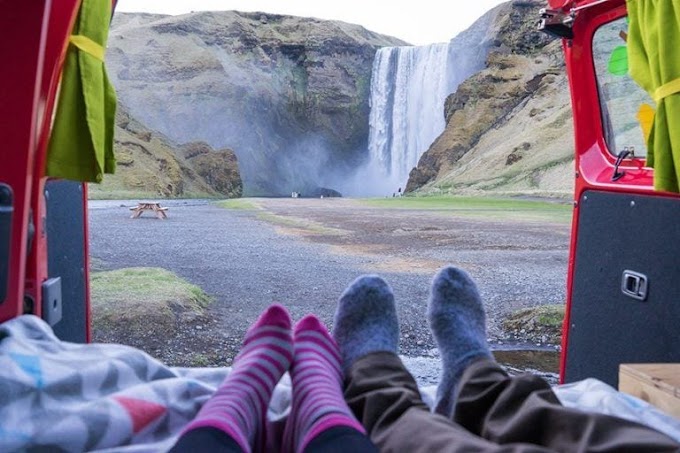Winter hiking boots have evolved tremendously over the past 10 years and are now lighter weight and more comfortable than ever before. Gone are the days when you needed to choose between military surplus boots, plastic mountaineering boots, or heavy pac boots to keep your feet warm. Today’s winter boots are waterproof, breathable, and insulated to keep you warm down to -40 Fahrenheit or more. They’re also optimized for walking over ice and packed snow, and compatible with traction aids such as microspikes and snowshoes. Whether you’re climbing mountains or snowshoeing across mixed terrain, the latest generation of winter hiking boots will keep you warm and dry.
Here are our top 10 best winter hiking boot recommendations:
1. Salomon Toundra Pro CS WP

Salomon’s Toundra Pro CS WP was the first winter hiking boot to incorporate ultralight Aerogel insulation developed by NASA for spaceflight. Rated to -40F, these popular winter hiking boots have a large comfortable toe box. a reinforced toe kick for added protection, and a heel cap that is compatible with microspike and snowshoe bindings. An arch in the midsole provides gaiter compatibility, while a fleece-lined tongue and upper boot provide a cushy, comfortable fit. I’ve been wearing the Toundra Pro for the past few winters and think they’re a great cold-weather hiking boot. The Salomon Toundras run true to size. A women’s Toundra Pro CS WP is also available. Read our Salomon Toundra Review
Check for the latest price at:
REI | Moosejaw | Amazon | Zappos
REI | Moosejaw | Amazon | Zappos
2. KEEN Summit County

The KEEN Summit County is also rated to -40F, but it has more insulation positioned in the toe box than in the upper cuff to keep your feet warmer. These winter boots have KEEN’s large signature toe box and run a bit wide, so they’re good for people who have a hard time jamming their feet into narrow boots. A beefy toe kick, heel cap, and excellent side protection make these boots ideal for challenging terrain, while a heat-reflective footbed covered with wool adds warmth from below. Read our Keen Summit County Review.
Check for the latest price at:
KEEN | REI | Zappos
KEEN | REI | Zappos
3. Vasque Snowburban II UltraDry

Vasque’s Snowburban II UltraDry boots are beefy winter hiking boots insulated with 400 gram Thinsulate synthetic insulation. They have leather uppers with a waterproof lining to keep your feet dry and a slight arch for gaiter compatibility. The EVA midsole has a thermoplastic urethane shank which is lightweight but helps cushion and protect your foot from sharp rocks while relieving calf stress on descents. A wool collar helps reduce odors and increases comfort for all-day use. Read our Snowburban II Review. The women’s version of this boot is called the Vasque Pow Pow III.
Check for the latest price at:
REI | Amazon | Zappos
REI | Amazon | Zappos
4. Merrell Thermo Freeze

The Merrell Thermo Freeze is a mid-sized winter hiking boot with 400-gram insulation. The height of the boot’s cuff is just 6″, so they’re much lighter weight than boots that run higher up your calf. The Thermo Freezes have a protective toe cap and heel cup, but less lateral protection than boots with heavy wraparound rands. EVA midsoles and molded nylon arch shanks deliver cushioning and stability. A generous arch provides gaiter compatibility, but the boots do not have a front gaiter ring so you’ll need to clip them to your laces. A women’s model is available.
Check for the latest price at:
Moosejaw | Amazon | Zappos
Moosejaw | Amazon | Zappos
5. The North Face Chilkat 400

The Chilkat 400 is the North Face’s cold weather winter boot, rated to -40F and insulated with 400 gram Primaloft Silver Eco insulation. They have a waterproof full-grain leather upper with a heavy-duty wrap-around rand, protective toe cap, and snowshoe compatible heel cup. A compression-molded EVA midsole provides good support, while extra hell cushioning and forefoot pads provide enhanced comfort. The lacing system has durable rust-proof metal hardware and a gaiter D-ring is provided. They run a full size small, so size up if you plan to wear a thick sock. A women’s model is available.
Check for the latest price at:
The North Face
The North Face
6. Oboz Bridger 10″ Insulated BDry Winter Boots

Oboz Bridger 10″ BDry Winter Boots are lined with a waterproof membrane and insulated with 400 gram Thinsulate. The uppers are covered with synthetic leather for added protection, along with a beefy toe cap, and snowshoe compatible heel cup. An arched sole and front D ring provide gaiter compatibility, while aggressive lugs provide excellent traction on snow. The Bridgers have a PU midsole and nylon shank for added undercarriage protection and come with a wool-covered reflective insole for added warmth. A 9″ women’s model is also available. Read our Oboz Bridger 10″ Review.
Check for the latest price at:
REI | Amazon | Campsaver
REI | Amazon | Campsaver
7. Merrell Thermo Glacier Mid Waterproof Boot

The Merrell Thermo Glacier Mid WP Winter Boot is insulated with 400 gram insulation, in addition to extra Aerogel over the toes, making them good for people with chronically cold toes. They have metal lacing hardware which is easier to use, reinforced rubber toe caps for front protection, a fleece liner for warmth, and heat-reflecting insoles that radiate body heat back toward your feet. Compression-molded EVA midsoles and molded nylon arch shanks provide cushioning and stability, while the 5 mm Vibram lugs provide excellent traction on snow and ice. A women’s version is not available at this time.
Check for the latest price at:
REI | Amazon| Zappos
REI | Amazon| Zappos
8. Columbia Bugaboot Plus IV XTM Omni-Heat Winter Boots

Columbia makes many varieties of Bugaboots, but we think the Plus IV XTM is the best model for winter hiking if you have really cold feet. The Plus IV has 600-gram insulation and is rated down to -65F. A wraparound waterproof rand provides good lateral protection, while a robust toe cap and heel cup work well with microspikes and other traction aids. An arched midsole and front gaiter clip ensure gaiter compatibility, while a padded tongue and collar provide all-day comfort. The extra tall cuff also helps seal in heat. The fit runs slightly wide, so these are a good option for people with larger feet. A women’s model is also available.
Check for the latest price at:
Columbia | Amazon | Zappos
Columbia | Amazon | Zappos
9. La Sportiva Nepal EVO GTX Mountaineering Boots

While most winter hikers use lightweight insulated hiking boots with microspikes for traction, there are times when a stiff-soled mountaineering boot and full mountaineering crampons are required. The La Sportiva Nepal Evo is a single skin leather mountaineering boot lined with Gore-Tex Duratherm, a lightweight and waterproof insulation layer. They have a rigid TPU last and innovative lace locks so you can get the lacing tight enough to front point with crampons. An integrated mini gaiter helps seal the top of the boots for greater warmth and keeps out debris, while front and rear welts enable compatibility with all crampon types.
Check for the latest price at:
REI | Amazon | Moosejaw
REI | Amazon | Moosejaw
10. Scarpa Mont Blanc Pro GTX Boot

The Scarpa Mont Blanc Pro GTX is a waterproof mountaineering boot with an integrated gaiter like the La Sportiva Nepal Evo GTX, listed above. It’s insulated with Gore-Tex Comfort, another waterproof breathable liner layer. It has a sturdy PU midsole and nylon shank for rigidity and shock absorption, with front and rear lugs that provide universal crampon compatibility. The fit runs wide and has a large toe box, while all-metal lacing hardware lets you lock in a good fit for front pointing. A women’s model is also available.
Check for the latest price at:
REI | Moosejaw | Amazon
REI | Moosejaw | Amazon
How to Select Winter Hiking Boots
Winter boots should be waterproof and insulated to keep your feet dry and warm, they should have laces, they should be comfortable so you can wear them all day, and they should be compatible with traction aids like microspikes and snowshoes. While the amount of insulation you need will vary, winter boots with non-removable synthetic insulation are the lightest weight and therefore the easiest to hike in. Boots made with synthetic materials are also lighter weight and more waterproof than leather boots.
The reason you can’t use your regular 3 season boots or shoes for winter hiking, comes down to waterproofing and insulation. Most insulated winter hiking boots are guaranteed waterproof out of the box. Many have lowers made with rubber or waterproof synthetics so you don’t have to worry about the fabric absorbing water. If you do get moisture in your boots, insulated winter boots will still keep them warm. The same can’t be said about leather hiking boots, even when treated with waterproofing creams and sprays. If your regular hiking boots absorb water in winter, they can freeze and lead to frostbite.
Some boot manufacturers provide temperature ratings for their products, but there’s no standard way for measuring the warmth of winter boots. Understand that these ratings are estimates at best and that users will have varying experiences based on their activity level, health, weight, sex, metabolism, and other factors.
Some winter boot manufacturers publish the thickness of the insulation in their boots, while others don’t. For example, some boots have 200 gram Thinsulate insulation, a popular synthetic insulation, while others use 400-gram insulation. All of the boots listed above have 400-gram insulation or the equivalent, so they can be used well below zero. This is the insulation we recommend if you hike in the backcountry, where winter hikes may last far longer than anticipated.
Key Winter Boot Features
Temperature ratings
While you need to take manufacturer’s temperature ratings with a grain of salt, they are a good indication of the relative warmth of a boot. While it’s difficult to make warmth comparisons between boots that have different kinds of insulation, knowing the amount of insulation used in boots can help you compare the warmth of different models made by the same manufacturer.
Gusseted tongue
This is just like a regular boot tongue, except the sides are closed and sewn to side of the boots to prevent water from leaking into the boot when you step in puddles.
Reinforced toe cap
In addition to providing more protection, a beefy toe cap won’t collapse the front of the boot when worn with microspikes or crampons.
Lugs
The soles of your boots should provide good traction when walking on loose or packed snow. Look for boots with a deep tread like a Vibram sole, although you’re likely to augment your boot with microspikes.
Cuff
Looks for boots with a soft cuff that closes off the gap between your leg and boot.
Gaiter ring
A gaiter ring is a small ring attached to the top of the boot that you can hook your gaiters onto. It’s not the end of the world if your boots don’t have one since can still hook the gaiter to your boot laces.









0 Comments